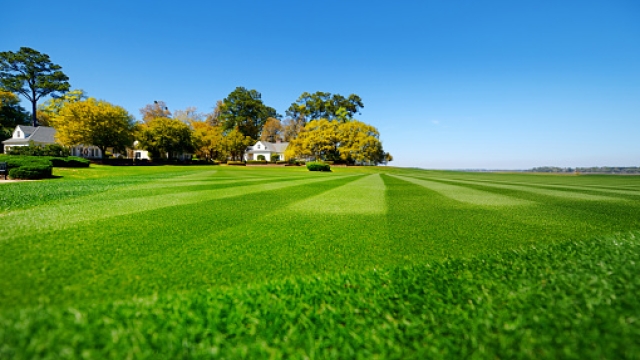Creating a lush and green lawn is a dream for many homeowners. A well-maintained lawn not only enhances the beauty of your home but also provides a refreshing space to relax and enjoy the outdoors. However, achieving that picture-perfect lawn requires a combination of dedication, knowledge, and proper lawn care techniques. In this comprehensive guide, we will dive into the world of lawn care, covering everything from lawn mowing to essential tips for promoting healthy grass growth. By following these guidelines, you’ll be well on your way to achieving a vibrant and envy-worthy lawn that will make your neighbors green with envy! So, let’s roll up our sleeves and get ready to transform your lawn into an oasis of lushness.
Proper Mowing Techniques
In order to achieve a lush and green lawn, it is crucial to employ proper mowing techniques. By following these guidelines, you can ensure that your lawn remains healthy and looks its best.
Firstly, it is important to mow your lawn at the appropriate height. Ideally, you should aim to keep your grass at a height of around 2.5 to 3 inches (6.4 to 7.6 centimeters). This length promotes healthier root growth and helps to prevent weed growth. However, it is essential to avoid cutting the grass too short, as this can lead to stress and damage to the lawn.
Secondly, regular mowing is key to maintaining a beautiful lawn. It is recommended to mow your lawn once a week during the growing season. This frequency ensures that you are removing only the top third of the grass blades, which promotes healthier growth. Additionally, regular mowing helps to prevent the accumulation of thatch, which can suffocate the grass and hinder its growth.
Lastly, it is advisable to vary your mowing pattern each time you cut the grass. Alternating the direction in which you mow helps to prevent the grass from leaning in one direction, resulting in a more uniform and attractive appearance. By changing the pattern, you also minimize soil compaction and ensure that the grass receives even sunlight distribution.
By employing these proper mowing techniques, you can maintain a well-groomed and vibrant lawn that becomes the envy of your neighborhood. Remember to adjust your mowing schedule based on weather conditions and always use sharp blades for clean, precise cuts.
Essential Lawn Care Practices
Regular Lawn Mowing:
A key practice for maintaining a lush and green lawn is regular mowing. By ensuring that your lawn is regularly and evenly cut, you can promote healthy growth and discourage the invasion of weeds. Set a consistent mowing height that suits your grass type, as cutting too low can stress the plants, while cutting too high may encourage weed growth. Remember to remove any accumulated debris from the mower blades before each use to prevent the spread of diseases.Adequate Watering:
Proper watering is essential for maintaining a healthy lawn. Water your lawn deeply but infrequently, aiming for around 1 inch of water per week. This will encourage deep root growth, making your grass more resilient to drought conditions. Watering in the morning or early evening reduces water loss due to evaporation. To determine if your lawn needs watering, simply check the moisture level of the soil by inserting a screwdriver into the ground. If it goes in easily, your lawn is adequately watered.
Zoysia Grass In TexasLawn Care:
Apart from mowing and watering, there are additional lawn care practices that can help keep your lawn looking vibrant. Regularly aerate your lawn by creating small holes to improve airflow and water absorption. This will prevent soil compaction and promote better nutrient uptake. Applying a suitable fertilizer can also provide the necessary nutrients for optimal lawn growth. Lastly, be vigilant in controlling weeds, pests, and diseases by using appropriate treatments and regularly inspecting your lawn for signs of damage.
Troubleshooting Common Lawn Issues
Lawn Issue #1: Weed Infestation
Weeds can be a nuisance in maintaining a lush and green lawn. They compete with the grass for nutrients, sunlight, and water, causing the grass to weaken and thin out. To tackle this issue, it is crucial to identify the types of weeds present in your lawn and choose the appropriate herbicide to eliminate them effectively. Regularly mowing your lawn at the proper height and ensuring good soil health through proper fertilization can also help prevent weed growth.
Lawn Issue #2: Brown Patches
Brown patches can be a sign of various problems, such as inadequate watering, fungal diseases, insect infestation, or even poor soil drainage. To determine the cause, examine the affected areas closely. If the brown patches are due to lack of watering, adjust your irrigation schedule to ensure proper hydration. For fungal diseases or insect infestation, consult a professional to identify the specific problem and recommend suitable treatments. Enhancing soil drainage can help prevent future occurrences.
Lawn Issue #3: Thin or Bare Areas
Thin or bare areas in the lawn can be caused by heavy foot traffic, improper mowing techniques, or insufficient sunlight. To revive these areas, start by aerating the soil to improve air circulation and water absorption. Overseeding with the appropriate grass seed can help thicken the lawn. Adjusting your mowing height and frequency can also promote healthier grass growth. Additionally, consider trimming overhanging branches to allow more sunlight to reach the affected areas.
Remember to regularly inspect your lawn, address issues promptly, and adjust your lawn care routine accordingly to ensure you maintain a lush and green lawn throughout the year.



